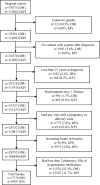Sociodemographic and clinical characteristics are not clinically useful predictors of refill adherence in patients with hypertension
- PMID: 20031876
- PMCID: PMC2768296
- DOI: 10.1161/CIRCOUTCOMES.108.841635
Sociodemographic and clinical characteristics are not clinically useful predictors of refill adherence in patients with hypertension
Abstract
Background: Although many studies have identified patient characteristics or chronic diseases associated with medication adherence, the clinical utility of such predictors has rarely been assessed. We attempted to develop clinical prediction rules for adherence with antihypertensive medications in 2 healthcare delivery systems.
Methods and results: We performed retrospective cohort studies of hypertension registries in an inner-city healthcare delivery system (n=17 176) and a health maintenance organization (n=94 297) in Denver, Colo. Adherence was defined by acquisition of 80% or more of antihypertensive medications. A multivariable model in the inner-city system found that adherent patients (36.3% of the total) were more likely than nonadherent patients to be older, white, married, and acculturated in US society, to have diabetes or cerebrovascular disease, not to abuse alcohol or controlled substances, and to be prescribed fewer than 3 antihypertensive medications. Although statistically significant, all multivariate odds ratios were 1.7 or less, and the model did not accurately discriminate adherent from nonadherent patients (C statistic=0.606). In the health maintenance organization, where 72.1% of patients were adherent, significant but weak associations existed between adherence and older age, white race, the lack of alcohol abuse, and fewer antihypertensive medications. The multivariate model again failed to accurately discriminate adherent from nonadherent individuals (C statistic=0.576).
Conclusions: Although certain sociodemographic characteristics or clinical diagnoses are statistically associated with adherence to refills of antihypertensive medications, a combination of these characteristics is not sufficiently accurate to allow clinicians to predict whether their patients will be adherent with treatment.
Figures
Similar articles
-
Predictors of adherence to concomitant antihypertensive and lipid-lowering medications in older adults: a retrospective, cohort study.Drugs Aging. 2008;25(10):885-92. doi: 10.2165/00002512-200825100-00008. Drugs Aging. 2008. PMID: 18808213
-
Adherence to Antihypertensive Therapy and Elevated Blood Pressure: Should We Consider the Use of Multiple Medications?PLoS One. 2015 Sep 11;10(9):e0137451. doi: 10.1371/journal.pone.0137451. eCollection 2015. PLoS One. 2015. PMID: 26359861 Free PMC article.
-
Association between dispensing channel and medication adherence among medicare beneficiaries taking medications to treat diabetes, high blood pressure, or high blood cholesterol.J Manag Care Spec Pharm. 2014 Aug;20(8):851-61. doi: 10.18553/jmcp.2014.20.8.851. J Manag Care Spec Pharm. 2014. PMID: 25062079 Free PMC article.
-
Simultaneous control of diabetes mellitus, hypertension, and hyperlipidemia in 2 health systems.Circ Cardiovasc Qual Outcomes. 2012 Sep 1;5(5):645-53. doi: 10.1161/CIRCOUTCOMES.111.963553. Epub 2012 Jul 31. Circ Cardiovasc Qual Outcomes. 2012. PMID: 22851534 Free PMC article.
-
Priorities for Research on Hypertension Care Delivery: A WHO Report Executive Summary.Hypertension. 2025 Jun;82(6):971-976. doi: 10.1161/HYPERTENSIONAHA.125.24702. Epub 2025 Mar 20. Hypertension. 2025. PMID: 40109247 Review.
Cited by
-
Effects of emotional response on adherence to antihypertensive medication and blood pressure improvement.Int J Hypertens. 2013;2013:358562. doi: 10.1155/2013/358562. Epub 2013 Feb 3. Int J Hypertens. 2013. PMID: 23431420 Free PMC article.
-
Examining the Drivers of Racial/Ethnic Disparities in Non-Adherence to Antihypertensive Medications and Mortality Due to Heart Disease and Stroke: A County-Level Analysis.Int J Environ Res Public Health. 2021 Dec 2;18(23):12702. doi: 10.3390/ijerph182312702. Int J Environ Res Public Health. 2021. PMID: 34886429 Free PMC article.
-
Medication adherence among cardiac patients in Khartoum State, Sudan: a cross-sectional study.Cardiovasc J Afr. 2017 Nov/Dec 23;28(6):350-355. doi: 10.5830/CVJA-2017-016. Epub 2017 Mar 23. Cardiovasc J Afr. 2017. PMID: 28345729 Free PMC article.
-
Health Information Technology: Meaningful Use and Next Steps to Improving Electronic Facilitation of Medication Adherence.JMIR Med Inform. 2016 Mar 15;4(1):e9. doi: 10.2196/medinform.4326. JMIR Med Inform. 2016. PMID: 26980270 Free PMC article.
-
Social Risk Factors for Medication Nonadherence: Findings from the CARDIA Study.Am J Health Behav. 2020 Mar 1;44(2):232-243. doi: 10.5993/AJHB.44.2.10. Am J Health Behav. 2020. PMID: 32019655 Free PMC article.
References
-
- Haynes RB, McDonald HP, Garg AX. Helping patients follow prescribed treatment: clinical applications. JAMA. 2002;288:2880–2883. - PubMed
-
- Mann DM, Allegrante JP, Natarajan S, Halm EA, Charlson M. Predictors of adherence to statins for primary prevention. Cardiovasc Drugs Ther. 2007;21:311–316. - PubMed
-
- Bagchi AD, Esposito D, Kim M, Verdier J, Bencio D. Utilization of, and adherence to, drug therapy among Medicaid beneficiaries with congestive heart failure. Clin Ther. 2007;29:1771–1783. - PubMed
Publication types
MeSH terms
Substances
Grants and funding
LinkOut - more resources
Full Text Sources
Medical


